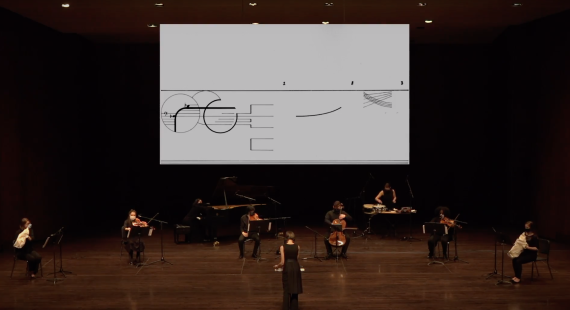The University of Washington Modern Music Ensemble (Cristina Valdés, director) performs works by Jonathan Harvey, Wolfgang Rihm, Luciano Berio, Nicole Lizée, and an improvised duet for ensemble and conductor, led by School of Music professor Steph Richards.
Program
Still for tuba and electronics (1997): Jonathan Harvey (1939-2012)
Cole Henslee, tuba
Drei Vorspiele zu einer Insel (2003): Wolfgang Rihm (1952-2024)
Sehr ruhig
Sehr rasch
Sehr ruhig
Rachel Reyes, flute; Taylor DeCastro, violin; Tyler Smith, percussion
O King (1968): Luciano Berio (1925-2003)
Cassidy Cheong, voice; Rachel Reyes, flute; Cameron DeLuca, clarinet; Taylor DeCastro, violin; Christine Lee, cello; Olivia Hsu, piano
Music for Body-Without-Organs (2011): Nicole Lizée. (b. 1973)
Rachel Reyes, flute & bass flute; Cameron Deluca, clarinet, bass clarinet & harmonica; Taylor DeCastro, violin; Christine Lee, cello; Ella Kalinichenko, piano; Tyler Smith, percussion
Conduction #148 (2025): Steph Richards (b. 1982)
an improvised duet for ensemble and conductor
Cassidy Cheong, voice; Rachel Reyes, flute; Cameron DeLuca, clarinet; Cole Henslee, tuba; Taylor DeCastro, violin; Olivia Hsu, piano; Tyler Smith, percussion; Steph Richards, conductor
Program Notes
Still for tuba and electronics (1997)
Known for his musical ideas and technological innovations, English composer Jonathan Harvey (1939-2012) was deeply influenced by spirituality and sought a musical space beyond time–a “new type of music”. This search for a free, flexible musical language led him to utilize the capabilities of electronics to further explore a new sonic landscape he coined as “the new Pythagoreanism” in the late 1990s. His work for solo tuba and electronics, Still (1997), calls for the soloist to improvise around a series of eight chords. The combination of sustained reverberated chords and free improvisation create eight new musical scenes.
—Rachel Reyes
O King (1968)
Moved by the death of the American civil-rights activist, Martin Luther King Jr., Luciano Berio (1925-2003) wrote a short piece with the text consisting solely of his name. O King (1968) was initially composed for voice, flute, B-flat clarinet, violin, cello, piano and calls for the voice to blend in as a part of the ensemble. The vocal part begins with just the vowels followed by the consonants of Martin Luther King Jr.’s name. At the climax of the piece, the voice soars above the ensemble and gives his name in full during the final few measures. Following the completion of the chamber version, Berio included a symphonic edition of this piece as the second movement of Sinfonia (1968-69) for eight amplified voices and orchestra.
—Rachel Reyes
Music for Body-Without-Organs (2011)
Deleuze and Guattari’s body-without-organs is defined as an anomalous shapeshifter—it is fluid, boundless, mutable, and in a continual process of ‘becoming’—no longer confined by the medical profession’s corporeal boundaries. In her book Deleuze and Horror Film author Anna Powell analyses horror film from a Deleuzian perspective and conceptualizes the body-without-organs as it applies to certain films and characters from the genre. Cronenberg’s Videodrome, Tourneur’s Cat People, Verhoeven’s Hollow Man are some of the films that feature this type of entity. She also looks in great depth at the literal body-without-organs: i.e. the character Frank Cotton in Clive Barker’s Hellraiser whose organs gradually restore themselves throughout the film after being torn to shreds by the Cenobites.
Music for Body-Without-Organs is a sonic representation of this continuous process of movement and flux and the fusion of elements to form new entities. It is what I imagine these characters would dance or listen to while going about their business. The work is continuously shifting and mutating. It has moments of trance-like material, elements of glitch, psychedelic touches, and a distorted interpretation of ambient music.
While composing the piece I also envisioned a striking scene from Herk Harvey’s 1962 cult classic Carnival of Souls. It involves the main character Mary Henry, who is perhaps a zombie, possessed, or simply undead (it is never really made clear, only that there is something “off” about her). While practicing hymns alone in church one night she falls into a trance. The hymns suddenly mutate into eerie and twisted melodies. Her pointed toes begin to work the organ’s pedals with fierce abandon. Her fingers rapidly caress the keys with more and more urgency while she sways and contorts her body to the music. As she moves deeper into a trance, ghouls materialize and begin dancing to her demonic music. Arriving in time to avert the song’s conclusion, the church’s minister appears, pulls her hands off of the keys and proclaims the music sacrilege.
—Nicole Lizée
Drei Vorspiele zu einer Insel (2003)
The highly prolific composer Wolfgang Rihm (1952-2024) was one of the leading figures of the new wave of German music in the 1970s that leaned more towards free expression and emotion over structuralism. His profound interests in visual arts, literature, and philosophy greatly influenced his works. Having described himself as a “pathless wanderer”, his works explore an unrestrained musical climate–free to meander and move towards unforeseen possibilities of colors and forms. Drei Vorspiele zu einer Insel (2003) or Three Preludes for an Island showcase Rihm’s musical ideals in three short movements for flute, violin, and percussion. Each movement traverses diverse musical climates moving from ethereal motifs, cacophonous explosions, and long winding melodies that disappear into the atmosphere.
Rachel Reyes
Conduction #148 (2025)
an improvised duet for ensemble and conductor
—Steph Richards
Biographies

Recently hailed by Fanfare Magazine as “excellent” and “clearly sensitive,” Cuban-American pianist Cristina Valdés is known for presenting innovative concerts with repertoire spanning over 300 years. A fierce advocate for new music, she has premiered countless works, including many written for her. She has performed across four continents and in venues such as Lincoln Center, Benaroya Hall, Carnegie Recital Hall, Le Poisson Rouge, Roulette, Miller Theatre, Jordan Hall, and the Kennedy Center. Ms. Valdés has appeared both as a soloist and chamber musician at festivals worldwide including New Music in Miami, the Foro Internacional de Música Nueva in Mexico City, Brisbane Arts Festival, the Festival of Contemporary Music in El Salvador, Havana Contemporary Music Festival, and the Singapore Arts Festival.
An avid chamber musician and collaborator, Ms. Valdés has toured extensively with the Bang On a Can “All Stars”, and has performed with the Seattle Chamber Players, the Mabou Mines Theater Company, the Parsons Dance Company, and Antares. Her performances on both the Seattle Symphony’s Chamber Series and [UNTITLED] concerts have garnered critical acclaim, including her “knockout” (Seattle Times) performance of Bartok’s Sonata for Two Pianos and Percussion, and her “arrestingly eloquent performance” of Dutilleux’s Trois Preludes (Bernard Jacobson/MusicWeb International).
Ms. Valdés has appeared as concerto soloist with the Seattle Symphony, Seattle Philharmonic, the Lake Union Civic Orchestra, Johns Hopkins Symphony Orchestra, the Binghamton Philharmonic, NOCCO, Philharmonia Northwest, the Eastman BroadBand, and the Stony Brook Symphony Orchestra, amongst others. In 2015 she performed the piano solo part of the Ives 4th Symphony with the Seattle Symphony under the direction of Ludovic Morlot, which was later released on CD to critical acclaim and made Gramophone’s list of Top 10 Ives Recordings. Other recent recordings include Orlando Garcia’s From Darkness to Luminosity with the Málaga Philharmonic on the Toccata Classics label, and the world premiere recording of Kotoka Suzuki’s Shimmer, Tree | In Memoriam Jonathan Harvey. She can also be heard on the Albany, Newport Classics, Urtext, and Ideologic Organ labels.
In recent seasons she gave performances of Beethoven’s Piano Concerto No. 3, Bartok’s Piano Concerto No. 3, the world-premiere performance of Carlos Sanchez-Guttierez’s Short Stories for piano and string orchestra with the Orquesta de Cámara de Bellas Artes in Mexico City, and the US Premiere of Under Construction for solo piano and tape playback by Heiner Goebbels at Benaroya Hall. Last season included a wide variety of performances including Gershwin’s Rhapsody in Blue, the premiere of her own composition Sketches of an Anniversary Prelude for trumpet and piano, and the premiere of composer Jeremy Jolley’s (contro-)clessidra IV for piano and electronics written especially for her.
Since 2006 she has made her home in Seattle where she has been an integral part of the new music scene. Ms. Valdés founded the SLAM Festival, a new music festival dedicated to the music of Latin-American composers, and is a core member of the Seattle Modern Orchestra - the only large chamber orchestra in the Pacific Northwest solely dedicated to the music of the 20th and 21st centuries. With the Seattle Modern Orchestra, she has premiered works by Anahita Abbasi, Darius Jones, Wang Lu, Kaley Eaton, Jeremy Jolley, and Yigit Kolat, amongst others.
Ms. Valdés received a Bachelor of Music from the New England Conservatory of Music, and a Master of Music and Doctor of Musical Arts from SUNY Stony Brook. While at Stony Brook, she was a recipient of the Thayer Minority Fellowship, a member of the Stony Brook Graduate Piano Trio, and a winner of the Concerto Competition. She is currently an artist-in-residence at the University of Washington, where she teaches piano and is the director of the UW Modern Music Ensemble.

Stephanie "Steph" Richards is a dynamic improvisor known for her innovative approach to the trumpet and interdisciplinary expression as a composer. An “innately adventurous trumpeter,” (Downbeat), she has collaborated with visionaries Henry Threadgill, Anthony Braxton, Muhal Richard Abrams and John Zorn as well as art pop luminaries Yoko Ono, St. Vincent, David Byrne and Laurie Anderson. Characterized by The New York Times as “boldly inventive…Richards composes in ways that standard notation could never document,” her works span interactions with film, poetry, electronics, choreography and scent and have garnered critical acclaim including Record of the Year by the New York Times and Downbeat. Her seminal record Supersense (2019) featuring all-star improvisers Jason Moran, Stomu Takeishi and Kenny Wolleson includes multimedia artist Sean Raspet creating singular, abstract scents to both inform and converse with the recording.
Her work as an improviser has brought her into contact with progressive voices in jazz and experimental music, including Ravi Coltrane, Roscoe Mitchell, Mary Halvorson, Tomeka Reid, Nicole Mitchell, Ingrid Laubrock and Jeff Parker while her conducting work, informed by the concept of "Conduction" developed by Butch Morris, has taken her to orchestras around the world, where she continues to push the boundaries of musical expression.
As a founding member of Bang on a Can's Asphalt Orchestra and a collaborator with the International Contemporary Ensemble (ICE), Anthony Braxton's Tricentric Orchestra, Henry Threadgill's Kestra, and the Kronos Quartet, Richards’ ensemble work has resulted in hundreds of premiered works by composers including Nico Muhly, Tyondai Braxton and John Luther Adams, interdisciplinary artists Mike Kelley, Laurie Anderson and Yoko Ono, and with choreographers Susan Marshall, Paul Taylor, David Dorfman and the Merce Cunningham company. Prior to her arrival at the UW in Fall 2024, where she serves as professor of music, she was a longtime faculty member at the University of San Diego, California. Richards is a Yamaha artist.
